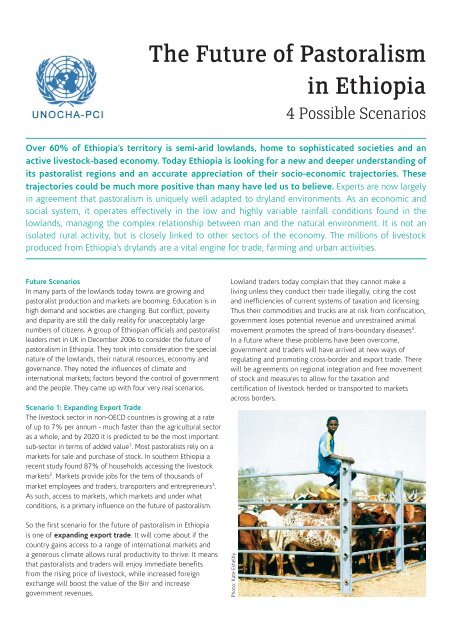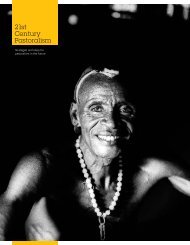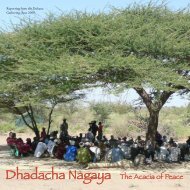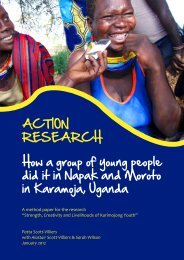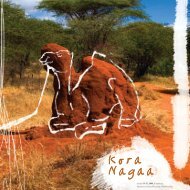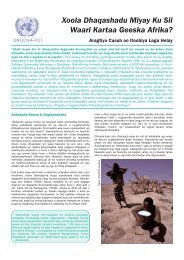Download PDF (304Kb) - the Website of the Pastoralist ...
Download PDF (304Kb) - the Website of the Pastoralist ...
Download PDF (304Kb) - the Website of the Pastoralist ...
Create successful ePaper yourself
Turn your PDF publications into a flip-book with our unique Google optimized e-Paper software.
The Future <strong>of</strong> Pastoralism<br />
in Ethiopia<br />
4 Possible Scenarios<br />
Over 60% <strong>of</strong> Ethiopia’s territory is semi-arid lowlands, home to sophisticated societies and an<br />
active livestock-based economy. Today Ethiopia is looking for a new and deeper understanding <strong>of</strong><br />
its pastoralist regions and an accurate appreciation <strong>of</strong> <strong>the</strong>ir socio-economic trajectories. These<br />
trajectories could be much more positive than many have led us to believe. Experts are now largely<br />
in agreement that pastoralism is uniquely well adapted to dryland environments. As an economic and<br />
social system, it operates effectively in <strong>the</strong> low and highly variable rainfall conditions found in <strong>the</strong><br />
lowlands, managing <strong>the</strong> complex relationship between man and <strong>the</strong> natural environment. It is not an<br />
isolated rural activity, but is closely linked to o<strong>the</strong>r sectors <strong>of</strong> <strong>the</strong> economy. The millions <strong>of</strong> livestock<br />
produced from Ethiopia’s drylands are a vital engine for trade, farming and urban activities.<br />
Future Scenarios<br />
In many parts <strong>of</strong> <strong>the</strong> lowlands today towns are growing and<br />
pastoralist production and markets are booming. Education is in<br />
high demand and societies are changing. But conflict, poverty<br />
and disparity are still <strong>the</strong> daily reality for unacceptably large<br />
numbers <strong>of</strong> citizens. A group <strong>of</strong> Ethiopian <strong>of</strong>ficials and pastoralist<br />
leaders met in UK in December 2006 to consider <strong>the</strong> future <strong>of</strong><br />
pastoralism in Ethiopia. They took into consideration <strong>the</strong> special<br />
nature <strong>of</strong> <strong>the</strong> lowlands, <strong>the</strong>ir natural resources, economy and<br />
governance. They noted <strong>the</strong> influences <strong>of</strong> climate and<br />
international markets; factors beyond <strong>the</strong> control <strong>of</strong> government<br />
and <strong>the</strong> people. They came up with four very real scenarios.<br />
Scenario 1: Expanding Export Trade<br />
The livestock sector in non-OECD countries is growing at a rate<br />
<strong>of</strong> up to 7% per annum - much faster than <strong>the</strong> agricultural sector<br />
as a whole, and by 2020 it is predicted to be <strong>the</strong> most important<br />
sub-sector in terms <strong>of</strong> added value 1 . Most pastoralists rely on a<br />
markets for sale and purchase <strong>of</strong> stock. In sou<strong>the</strong>rn Ethiopia a<br />
recent study found 87% <strong>of</strong> households accessing <strong>the</strong> livestock<br />
markets 2 . Markets provide jobs for <strong>the</strong> tens <strong>of</strong> thousands <strong>of</strong><br />
market employees and traders, transporters and entrepreneurs 3 .<br />
As such, access to markets, which markets and under what<br />
conditions, is a primary influence on <strong>the</strong> future <strong>of</strong> pastoralism.<br />
So <strong>the</strong> first scenario for <strong>the</strong> future <strong>of</strong> pastoralism in Ethiopia<br />
is one <strong>of</strong> expanding export trade. It will come about if <strong>the</strong><br />
country gains access to a range <strong>of</strong> international markets and<br />
a generous climate allows rural productivity to thrive. It means<br />
that pastoralists and traders will enjoy immediate benefits<br />
from <strong>the</strong> rising price <strong>of</strong> livestock, while increased foreign<br />
exchange will boost <strong>the</strong> value <strong>of</strong> <strong>the</strong> Birr and increase<br />
government revenues.<br />
Lowland traders today complain that <strong>the</strong>y cannot make a<br />
living unless <strong>the</strong>y conduct <strong>the</strong>ir trade illegally, citing <strong>the</strong> cost<br />
and inefficiencies <strong>of</strong> current systems <strong>of</strong> taxation and licensing.<br />
Thus <strong>the</strong>ir commodities and trucks are at risk from confiscation,<br />
government loses potential revenue and unrestrained animal<br />
movement promotes <strong>the</strong> spread <strong>of</strong> trans-boundary diseases 4 .<br />
In a future where <strong>the</strong>se problems have been overcome,<br />
government and traders will have arrived at new ways <strong>of</strong><br />
regulating and promoting cross-border and export trade. There<br />
will be agreements on regional integration and free movement<br />
<strong>of</strong> stock and measures to allow for <strong>the</strong> taxation and<br />
certification <strong>of</strong> livestock herded or transported to markets<br />
across borders.<br />
Photo: Kate Eshelby
The Future <strong>of</strong> Pastoralism in Ethiopia: June 2007<br />
<strong>Pastoralist</strong> women will find new economic opportunities,<br />
leading <strong>the</strong>m to more prominent roles in local communities.<br />
Local authorities will administer <strong>the</strong> collection <strong>of</strong> value added<br />
taxes which will be reinvested in supporting <strong>the</strong> local economy<br />
and social welfare. New roads and communication systems will<br />
help to get products to market intact and on time.<br />
‘<br />
In this future, suppliers will be using market and technical<br />
information to respond to price incentives, quickly increasing<br />
production and delivery and improving <strong>the</strong> quality <strong>of</strong> <strong>the</strong>ir<br />
products. They will be enjoying legal rights <strong>of</strong> access to land<br />
and o<strong>the</strong>r productive resources, and will carry out <strong>the</strong>ir<br />
responsibilities for protecting <strong>the</strong> environment. These rights and<br />
responsibilities will be administered by institutions that include<br />
both traditional and state representation.<br />
Reliance on foreign markets will mean new risks. Elites may<br />
accumulate excessive pr<strong>of</strong>its leaving <strong>the</strong> poorer members <strong>of</strong><br />
society dependent upon <strong>the</strong>m for employment. Livelihoods can<br />
quickly become contingent on tariffs, quality and health<br />
requirements and o<strong>the</strong>r barriers to trade. Subsidies in o<strong>the</strong>r<br />
countries could threaten to erode <strong>the</strong> competitiveness <strong>of</strong><br />
Ethiopian pastoralists, and with Ethiopia dependent on access<br />
to international ports through neighbouring countries, regional<br />
conflicts could disrupt trade. Making this scenario work well<br />
requires good governance and a fair society.<br />
Scenario 2: Added Value<br />
In contrast to <strong>the</strong> first scenario, if <strong>the</strong> climate is less generous,<br />
but high-price foreign markets are still accessible, <strong>the</strong>n<br />
lowlanders will add value to livestock production, ra<strong>the</strong>r than<br />
being able to increase <strong>the</strong> quantity <strong>of</strong> animals produced and<br />
sold. Successful pastoralists will need high levels <strong>of</strong> mobility in<br />
order to produce quality animals in a harsh climatic regime.<br />
<strong>the</strong> Borana<br />
pastoral system<br />
has higher returns<br />
<strong>of</strong> both energy<br />
and protein per<br />
hectare than<br />
industrialised<br />
ranching systems<br />
in Australia<br />
‘<br />
There will be fewer pastoralists,<br />
and people will diversify into a<br />
range <strong>of</strong> business activities<br />
such as forage supply,<br />
fattening, food processing and<br />
high quality manufacturing<br />
from skins and hides.<br />
Rural towns will grow and<br />
become more important, with<br />
small processing centres and<br />
factories and businesses that<br />
provide goods and services.<br />
Communications technologies<br />
will be widely accessible.<br />
Photo: Abdi Umar<br />
Too much reliance on rain-dependent products will add an<br />
element <strong>of</strong> risk to this scenario. High levels <strong>of</strong> conflict would<br />
also endanger success by interrupting pastoralist mobility,<br />
discouraging investment into value added industries and<br />
hampering access to markets. The success <strong>of</strong> this scenario is<br />
based on freeing up lowland capabilities to invest in new<br />
small industries and to access export markets with ease. It<br />
also relies on securing pastoralist abilities to be mobile and<br />
deliver animal products to <strong>the</strong> market despite <strong>the</strong> difficulties<br />
<strong>of</strong> a poor climate.<br />
Scenario 3: Sustained Pastoral Livelihoods<br />
If a good climatic regime allows livestock production to grow,<br />
but international markets are less accessible, Ethiopia will see<br />
sustained pastoral livelihoods persisting in <strong>the</strong> lowlands. This is<br />
not necessarily a negative scenario: grazing animals will move<br />
freely across <strong>the</strong> lowland landscape, people will be eating meat<br />
and milk, agro-pastoralism will play a part and small urban<br />
centres will provide services. Social services such as education<br />
and health will be tailored to mobile lifestyles and support <strong>the</strong><br />
growth <strong>of</strong> <strong>the</strong> rural economy.<br />
<strong>Pastoralist</strong>s will move between seasonal grazing areas, taking<br />
strategic advantage <strong>of</strong> different forage and water sources as<br />
<strong>the</strong>y become available. They are experts at maximising <strong>the</strong> use<br />
<strong>of</strong> rangelands, a capability demonstrated by numerous research<br />
studies. For example, studies have shown <strong>the</strong> Borana pastoral<br />
system having higher returns <strong>of</strong> both energy and protein per<br />
hectare than industrialised ranching systems in Australia 5 . To<br />
achieve <strong>the</strong>se high levels <strong>of</strong> productivity, pastoralists depend on<br />
access to key resources at specific times.<br />
Photo: Andrew Heavens
‘<br />
to do well,<br />
pastoralists<br />
require<br />
guaranteed<br />
access to<br />
key resource<br />
zones<br />
‘<br />
Some terrains, such as parts <strong>of</strong> Afar<br />
and Somali have low rainfall and<br />
poor soil nutrients. These rangelands<br />
can only be used productively by<br />
mobile pastoralists. O<strong>the</strong>r areas have<br />
higher rainfall or moisture levels but<br />
poor soil, resulting in abundant but<br />
low-quality forage for much <strong>of</strong> <strong>the</strong><br />
year. These woodlands and wetlands,<br />
like those found in Gambella and<br />
SNNPR, are used by pastoralists for<br />
part <strong>of</strong> <strong>the</strong> year and are <strong>of</strong>ten<br />
improved by <strong>the</strong> setting <strong>of</strong> controlled fires. Yet o<strong>the</strong>r areas<br />
have low rainfall but nutrient-rich soil, such as <strong>the</strong> volcanic<br />
soils found in <strong>the</strong> Rift Valley. These are important areas for<br />
pastoralists, providing flushes <strong>of</strong> vital nutrition for livestock<br />
for short but <strong>of</strong>ten unpredictable wet season intervals.<br />
Finally <strong>the</strong>re are key areas that have both high moisture and<br />
Photo: Peter Moszynski<br />
The Future <strong>of</strong> Pastoralism in Ethiopia: June 2007<br />
What makes this scenario successful is that policy-makers come<br />
to recognise that <strong>the</strong> pastoral production system is a source <strong>of</strong><br />
strength. They desist from wishing to turn pastoralists into<br />
farmers and support <strong>the</strong>m to increase and diversify productivity.<br />
Scenario 4: Alternative Livelihoods<br />
And lastly a scenario that may be <strong>the</strong> least desirable, but is<br />
entirely possible, comes about when both markets and<br />
production are poor and people seek alternative livelihoods.<br />
Reduced access to good grazing and lack <strong>of</strong> market access will<br />
prompt many pastoralists and farmers to leave a raindependent<br />
livelihood altoge<strong>the</strong>r in <strong>the</strong> search <strong>of</strong> better<br />
opportunities in rural towns and urban centres.<br />
The increased displacement <strong>of</strong> pastoralists could lead to a<br />
temporary surge in reliance on food aid and public cash<br />
transfers, but, as long as <strong>the</strong>se systems are not corrupt, new<br />
livelihood opportunities will begin to open up. With <strong>the</strong> right<br />
political will, tourism, communications, education and financial<br />
services could all see growing levels <strong>of</strong> investment and return.<br />
The pastoralists who continue to herd animals will eventually<br />
gain from <strong>the</strong> increase in alternative businesses and services<br />
and continued demand for livestock products. People who<br />
move into alternative livelihoods will invest in <strong>the</strong> pastoralist<br />
system and may rejoin it at will.<br />
Educational and vocational skill training centres will be<br />
needed in towns across pastoral areas, providing primary and<br />
secondary education and access to tertiary education,<br />
especially for women, but also <strong>of</strong>fering courses on how to<br />
establish small enterprises. Educated people will become<br />
more mobile in search <strong>of</strong> new sources <strong>of</strong> employment.<br />
Ethiopians abroad will be sending money back home to<br />
<strong>the</strong>ir relatives in pastoral areas, who in turn will look for<br />
productive investments. Government will <strong>of</strong>fer tax incentives<br />
to encourage private investors to invest in pastoral areas,<br />
especially where investments diversify and streng<strong>the</strong>n<br />
pastoral production.<br />
nutrient-rich soil found in pockets all over <strong>the</strong> lowlands. Where<br />
<strong>the</strong>se occur, <strong>the</strong>y form <strong>the</strong> ‘dry season grazing reserves’ that<br />
occur along watercourses and in valley floors. <strong>Pastoralist</strong>s,<br />
small farmers, irrigation schemes and wildlife reserves compete<br />
for exclusive use <strong>of</strong> <strong>the</strong>se resources. Yet to do well, pastoralists<br />
require guaranteed access to <strong>the</strong>se zones when all <strong>the</strong> o<strong>the</strong>r<br />
areas fail to produce forage. Without occasional access to key<br />
resources, pastoralist systems break down.<br />
So to make this sustained pastoral livelihoods scenario work,<br />
decentralised land-use institutions will have to guarantee<br />
pastoralist access to key resource areas, and promote<br />
cooperation between farmers, pastoralists and o<strong>the</strong>r land users.<br />
Collaboration between traditional and local authorities will<br />
produce collective land use agreements, legal instruments will<br />
provide clarity as to rights <strong>of</strong> land use and traditional and<br />
modern knowledge will be combined in guiding range<br />
management decisions.<br />
Photo: UN OCHA Ethiopia
‘<br />
The Future <strong>of</strong> Pastoralism in Ethiopia: June 2007<br />
Even today<br />
<strong>the</strong>re is already<br />
a strong export<br />
market, rural<br />
pastoralism is<br />
thriving in<br />
many areas<br />
‘<br />
Traditional and state<br />
administrations will work toge<strong>the</strong>r<br />
to ensure that new economic<br />
activities are successfully<br />
integrated into society and are<br />
regulated effectively.<br />
This alternative livelihoods<br />
scenario will have perhaps <strong>the</strong><br />
highest requirement for social<br />
welfare and this will mean<br />
collaboration between customary<br />
institutions and <strong>the</strong> state. In Somali region, a recent study<br />
found 17 different kinds <strong>of</strong> informal transfer giving help to<br />
<strong>the</strong> poorest and 39% <strong>of</strong> pastoralists had been lent or donated<br />
milking animals 6 . Such systems go beyond assistance to <strong>the</strong><br />
poor to focus attention on <strong>the</strong> distribution <strong>of</strong> <strong>the</strong> benefits <strong>of</strong><br />
production across <strong>the</strong> population. A decline in this capability<br />
and <strong>the</strong> parallel growth in <strong>the</strong> use <strong>of</strong> food aid or state safety<br />
nets is likely to have a significant effect on <strong>the</strong> success <strong>of</strong><br />
this scenario.<br />
So this may be <strong>the</strong> most difficult scenario to make successful,<br />
as it promises hardship as well as opportunity. Success will<br />
rely on securing good citizen-state relations in management<br />
<strong>of</strong> scarce resources, as much as on investing in education and<br />
reducing barriers to innovation. For a positive future under<br />
difficult conditions customary institutions will need to<br />
continue to play a central role in welfare, inter-community<br />
negotiations and management <strong>of</strong> communal access to key<br />
resource areas.<br />
Conclusion<br />
All <strong>of</strong> <strong>the</strong> scenarios depicted above are realistic and <strong>the</strong>y are<br />
not necessarily mutually exclusive. Even today <strong>the</strong>re is<br />
already a strong export market, rural pastoralism is thriving<br />
in many areas, people are beginning to add real value to<br />
livestock products, and diversification into alternative<br />
livelihoods is underway.<br />
Ethiopia’s lowlands are seeing a transformation in <strong>the</strong> way life<br />
and livelihoods are governed. The future will be built on<br />
opportunities for self-administration through federalism and<br />
decentralisation and concomitant changes in <strong>the</strong> role <strong>of</strong><br />
customary institutions. There will be growth in private sector<br />
activities and increasingly complex interconnections between<br />
a wide variety <strong>of</strong> producers, processors, traders,<br />
entrepreneurs, <strong>of</strong>ficials and consumers. What will be needed<br />
from government will be regulation <strong>of</strong> <strong>the</strong>se relationships and<br />
stimulation <strong>of</strong> <strong>the</strong> services required to develop an educated<br />
society and an active economy.<br />
Whe<strong>the</strong>r Ethiopia manages to forge a future for its lowland<br />
regions that maximises <strong>the</strong> opportunities <strong>of</strong>fered depends on<br />
how <strong>the</strong> state and <strong>the</strong> citizens co-operate. It depends on giving<br />
people <strong>the</strong> security <strong>the</strong>y need to take risks, make investments,<br />
contribute to governance and maintain a multitude <strong>of</strong> positive<br />
social ties. It depends on creating policies and practices that take<br />
into account <strong>the</strong> special nature and potential <strong>of</strong> <strong>the</strong> lowlands.<br />
Notes<br />
1. Ian Scoones and William Wolmer (2006) Livestock, Disease, Trade and Markets:<br />
Policy Choices for <strong>the</strong> Livestock Sector in Africa, Working Paper 269, Brighton:<br />
Institute <strong>of</strong> Development Studies.<br />
2. J.G. McPeak and P.D. Little (2006) Pastoral Livestock Marketing in Eastern Africa:<br />
Research and Policy Challenges, Rugby: Intermediate Technology Publications.<br />
3. Abdi Umar (2007) Risk Taking for a Living, Trade and Marketing in Somali Region,<br />
Addis Ababa: UN OCHA-PCI.<br />
4. D. K. Leonard, Editor (2000) Africa’s Changing Markets for Health and Veterinary<br />
Services: <strong>the</strong> New Institutional Issues, London: Macmillan.<br />
5. Ian Scoones (1995) Ed. Living with Uncertainty: New Directions in Pastoral<br />
Development in Africa, London: Intermediate Technology Publications.<br />
6. Stephen Devereux (2005) Vulnerable Livelihoods in Somali Region, Ethiopia,<br />
Research Report 57, Brighton: Institute <strong>of</strong> Development Studies.<br />
This paper is a summary <strong>of</strong> <strong>the</strong> booklet, ‘The Future <strong>of</strong><br />
Pastoralism in Ethiopia’, published by UN OCHA-PCI. If you<br />
would like a copy, please contact us at:<br />
UN OCHA <strong>Pastoralist</strong> Communication Initiative<br />
4th Floor, Old ECA Building, Addis Ababa, Ethiopia<br />
info@unocha-pci.org<br />
+251 (0) 115 444420<br />
Or you can download a copy from www.pastoralists.org<br />
Photo: Kate Eshelby<br />
The opinions expressed in this paper do not necessarily reflect those <strong>of</strong> <strong>the</strong> United Nations


